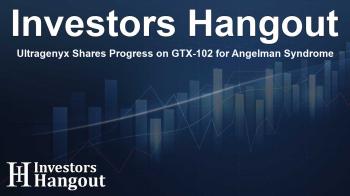Ultragenyx Shares Progress on GTX-102 for Angelman Syndrome

Ultragenyx Advances GTX-102 for Angelman Syndrome
Ultragenyx Pharmaceutical Inc. (NASDAQ: RARE) has recently shared promising insights regarding GTX-102, its investigational treatment for Angelman syndrome. During the 17th Annual Global Science Summit organized by the Foundation for Angelman Syndrome Therapeutics (FAST), data from the Phase 1/2 study highlighted notable improvements across various assessment domains, setting the stage for the upcoming Phase 3 Aspire study.
Positive Findings from Phase 1/2 Study
According to Dr. Eric Crombez, the Chief Medical Officer at Ultragenyx, the data reinforcing the Phase 3 Aspire study's primary endpoints of cognition are particularly encouraging. These findings suggest that the study is significantly powered to reveal clear differences in outcomes between the GTX-102 group and the sham control group. This is crucial for establishing efficacy as the company prepares to enter the next phase of clinical trials.
Enrollment Plans for Phase 3 Aspire Study
The Aspire study is poised to begin enrolling approximately 120 patients diagnosed with Angelman syndrome, specifically those with full maternal UBE3A gene deletion confirmed through genetic testing. It will include a detailed 48-week primary efficacy analysis, focusing primarily on cognitive improvement as measured by the Bayley-4 assessment. A key secondary endpoint will evaluate multiple areas of functioning, including cognition, communication, behavior, motor skills, and sleep.
Encouraging Results from Continued Evaluations
As of the latest data cut-off, patients in the Dose Expansion Cohorts have shown sustained improvements. Specifically, those in the treatment arms experienced a significant increase in cognitive scores, evidencing that the treatment effect surpasses the anticipated minimal valid difference. With over 95% statistical power projected, the Phase 3 study aims for a robust validation of the treatment's effectiveness.
Safety and Tolerability of GTX-102
GTX-102 has maintained a consistent safety profile, reinforcing its potential as a viable treatment option for individuals impacted by Angelman syndrome. The safety assessments are crucial, as GTX-102 is designed to alter gene expression in patients affected by this rare neurological condition.
Understanding Angelman Syndrome
Angelman syndrome is characterized by a neurogenetic disorder stemming from the loss of function of the UBE3A gene. The majority of patients face significant developmental challenges, including cognitive and motor impairments alongside seizures. Consequently, those diagnosed require constant care and support for daily activities. Despite not being genetic in nature—rather, it is a spontaneous occurrence—the condition affects an estimated 60,000 individuals across various regions.
Why GTX-102 Matters
GTX-102 works by targeting the UBE3A antisense transcript, aiming to restore the expression of the paternal UBE3A allele in neurons. Early animal model studies have indicated potential reversals of neurological symptoms, showcasing a bright future for treatments that can significantly improve quality of life for patients with Angelman syndrome. With various designations granted from regulatory bodies and an ambitious development pipeline, Ultragenyx's commitment to advancing this treatment option could represent a significant breakthrough in the management of this condition.
About Ultragenyx Pharmaceutical Inc.
Ultragenyx is dedicated to providing innovative therapies for rare and ultra-rare genetic diseases. With a diversified array of products, the company focuses on addressing high unmet medical needs where effective treatments are currently unavailable. The experienced leadership team drives the company's strategy towards efficient and timely drug development to bring safe and effective therapies to market.
Frequently Asked Questions
What is GTX-102?
GTX-102 is an investigational treatment developed by Ultragenyx to address the causes and symptoms associated with Angelman syndrome.
What were the key findings of the Phase 1/2 study?
The study showed significant improvements in cognitive abilities and a consistent safety profile, leading to preparations for the Phase 3 Aspire study.
Who will participate in the Phase 3 study?
About 120 patients with genetically confirmed Angelman syndrome will be recruited for the Phase 3 Aspire study.
What roles do the UBE3A gene and GTX-102 play?
UBE3A is crucial for cognitive functioning, and GTX-102 aims to reactivate the expression of this gene in patients with Angelman syndrome.
How does Ultragenyx plan to advance its drug development?
Ultragenyx is committed to time- and cost-efficient drug development, aiming to deliver effective therapies to patients quickly.
About Investors Hangout
Investors Hangout is a leading online stock forum for financial discussion and learning, offering a wide range of free tools and resources. It draws in traders of all levels, who exchange market knowledge, investigate trading tactics, and keep an eye on industry developments in real time. Featuring financial articles, stock message boards, quotes, charts, company profiles, and live news updates. Through cooperative learning and a wealth of informational resources, it helps users from novices creating their first portfolios to experts honing their techniques. Join Investors Hangout today: https://investorshangout.com/
Disclaimer: The content of this article is solely for general informational purposes only; it does not represent legal, financial, or investment advice. Investors Hangout does not offer financial advice; the author is not a licensed financial advisor. Consult a qualified advisor before making any financial or investment decisions based on this article. The author's interpretation of publicly available data shapes the opinions presented here; as a result, they should not be taken as advice to purchase, sell, or hold any securities mentioned or any other investments. The author does not guarantee the accuracy, completeness, or timeliness of any material, providing it "as is." Information and market conditions may change; past performance is not indicative of future outcomes. If any of the material offered here is inaccurate, please contact us for corrections.
